
July 12th, 2022
Today, I released my first monarch butterfly. It was a male I named Prime because he was the first caterpillar I had found this summer.
The Beginning: 2017 Caterpillar
My monarch butterfly journey began when I was babysitting my grandchildren. On July 24, 2017, my grandson asked me if I wanted to go hunting for monarch caterpillars. Walking past the corner field two houses west of my home, we found a very large monarch caterpillar. He was munching away on a milkweed plant. We brought Chris home on his milkweed leaf and put him in an empty peanut butter jar with some fresh, washed milkweed. My grandson went off to play and I spent the time watching and listening to the caterpillar munch away on its milkweed.
That year, I raised and released ten butterflies. I was hooked! I have been a Monarch Waystation since June 14, 2019.
2021 and 2022: Very Different Years
The summer of 2021 was going well. Monarch butterflies had arrived, and I found the first egg on June 5th. My greenhouse was perfect for monarch eggs and caterpillars, which I housed in an assortment of critter cages. On August 10th, everything changed. There had been a severe storm during the night. I woke to find my 8′ x 10′ greenhouse had been torn apart, scattering the critter cages throughout the yard. The monarch rescue began. Most of the chrysalides had survived. Some needed to be tied to the tops of the critter cages, some had damage to their wings when they emerged and couldn’t fly, and some chrysalides turned black and the butterflies never emerged. I rebuilt the greenhouse, secured it to the ground, and released my last monarch butterfly on August 28, 2021.
The last week in May 2022
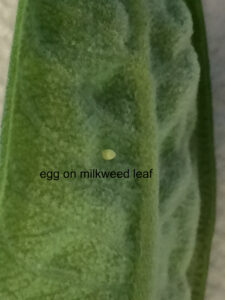
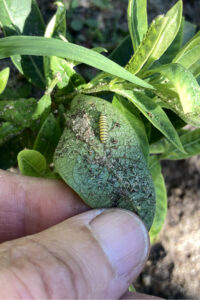
Even though I hadn’t seen any monarchs in my gardens, I began turning over milkweed leaves looking for eggs. Female monarchs lay a single egg that looks like a tiny iridescent football on the underside of a milkweed leaf. A female monarch can lay between 100 and 300 eggs during her lifespan of from two-to-six weeks. This is important because I live in Michigan and receive the third generation, or the grandchildren of monarchs that left their winter home in Mexico. The first generation mates and lays eggs in March and April in the southern USA. Their offspring wing their way north and lay their eggs in April and early May in the midsection of the USA. Their grandchildren arrive in Michigan in late May, mate, and lay their eggs until August in the northern USA. In August, the daylight hours change and the milkweed becomes old and yellows; this changes the chemistry of the caterpillars, and they go into reproductive diapause. These monarchs make up the 3000-mile south migration. They will not reproduce until they become the first group to head north and the next northern migration begins.
(“Neurobiology of Monarch Butterfly,” Annual Review of Entomology, 3.2016).
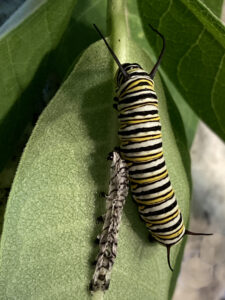
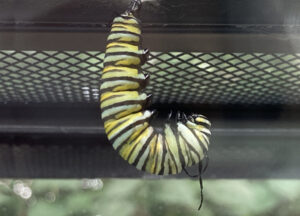
Indoor Habitat and Responsibility
Habitat is important. I use a greenhouse because the monarchs experience the same changes in light and temperature but are safer from insect predators. They also eat clean milkweed.
If you choose to raise a few monarch butterflies, they need a safe environment and a food source free from pesticides and predatory insects. Rinse the milkweed to get rid of Ophryocystis elektroscirrha (OE), which is a protozoan parasite that infects monarch caterpillars. In addition to potentially leaving them unable to pupate, they may have deformed wings when they emerge so they cannot fly or hold onto their chrysalis or a branch or leaf, etc. To help prevent the OE infection, rinse all milkweed before feeding it to the caterpillars. If you have a sick caterpillar or butterfly, isolate it in another cage and remove all the other caterpillars, as well as the monarchs in their various stages, from the infected area. Sanitize the empty cage or aquarium with a bleach solution of 10% bleach to water. Rinse the habitat several times to make sure that the bleach has done its job and that the container no longer has any bleach residue.
I, myself, cannot euthanize a butterfly that I have raised. The saddest part is that they will never get to flutter, flap their wings, or glide through the air. I make sure that the butterfly has a variety of cut nectar flowers or butterfly nectar on a non-scratch plastic scrubber. The scrubber will give them an easier access to food. I also put plastic netting on the walls of its living area so that it can move about as freely as possible. When it passes, I bury it in the yard.
As a monarch develops from egg to butterfly, we need to be responsible keepers. That means to be pesticide-free and grow a variety of milkweed and nectar flowers such as cone flowers, zinnias, cosmos, and lantana. Also raise them in a setting as close to nature as possible.
It is important to raise only a few monarch butterflies. The homegrown ones are less ready for the journey to Mexico. Sunlight is an important part of their navigation. If raised under artificial lighting, they may become confused and not adapt to the position or movement of the sun.
Do not plant tropical milkweed; it stops the reproductive diapause, and they will be sexually active and not make it through the overwintering in Mexico.
(“What’s Wrong With Butterflies Raised in Captivity,” NYT 4.8.2020)
Counting Milkweed and Monarchs: Monarch Blitz 2022
This was the first year I participated in the count that took place between July 29th and August 7th. It was conducted by Journey North, who sponsor the establishment of Monarch Waystations. This year, the International Union of Conservation of Nature has red-listed the migratory monarchs as endangered, which means that they are two steps from extinction. I decided to participate in the count and had 340 milkweed plants of four different varieties. In addition, I found three first instar caterpillars and one male monarch butterfly, no eggs, and no chrysalides. The saddest observation was that the milkweeds were covered with ants and very few leaves had the telltale crescent-shaped chew marks, the sign of a baby caterpillar leaving its egg. It had become food for another insect. I posted my results online. The response was the same from small and large monarch habitats: Very few sightings of monarchs and the milkweed remained untouched.
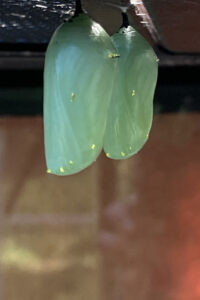
(Journey North Tracking Migrations and Seasons)
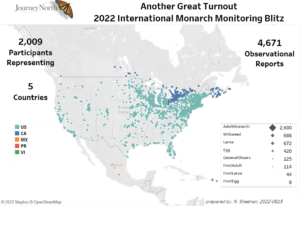
The Miracle
It is a wonderful opportunity to raise a monarch butterfly from egg to butterfly. Mother Nature was not kind when she created this creature. Its skin does not stretch, and it goes through five instars. The instar is the time between each skin molt so that it can continue to grow. The final instar is when it pupates. During this process, it weaves a knot on a branch or leaf, anchors its hind feet or anal claspers in the knot, and hangs in a J form. After 24 hours, its antennae, which were long and thin, begin to wrinkle and twist. The colored bands on its body begin to move up and down, and then its skin begins to split between its antennae. The old skin works its way up, revealing the new green skin underneath. It looks very alien.
The pupa dance helps the monarch fling off the old skin as it swings and twists its body around. It must tighten the knot to make it secure because the emerging monarch butterfly will need to hold onto the empty chrysalis as it emerges.
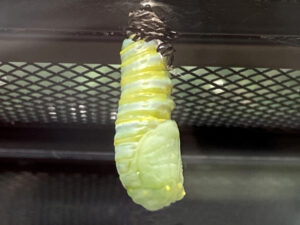
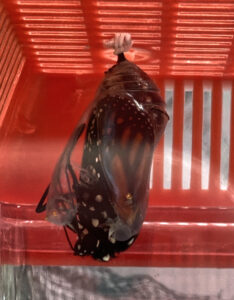
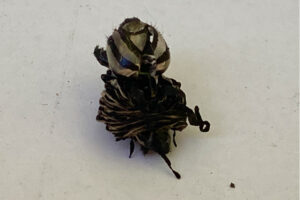
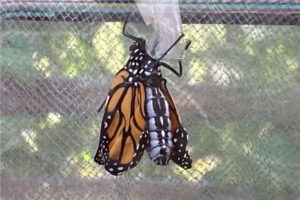
The beautiful jade green with gold dotted chrysalis will hang there for about ten days. On about the tenth day, the chrysalis darkens. Slowly, over the hours, it brightens and reveals the bright orange and black lines of its wings. The chrysalis opens, and the monarch hangs onto the fragile remains of its former home. Its belly begins pumping fluid into its wings as it holds on and swivels back and forth. If it falls and cannot fill its wings, it will never be able to fly. It is important to allow the monarch to dry its wings for three hours. When you see it walking back and forth on the top of the critter cage you know it is time to release your monarch butterfly to the world. Check the weather and keep it inside if storms are predicted. Add nectar flowers in a vase if the storms last more than a day. They usually don’t eat that first day. For me this never grows old. Each and every monarch butterfly is a miracle. The loss of the monarch butterfly will be the loss of one more pollinator and the loss of great grace and beauty.

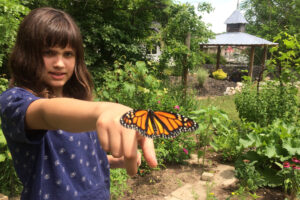
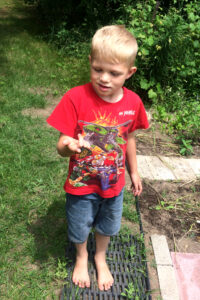
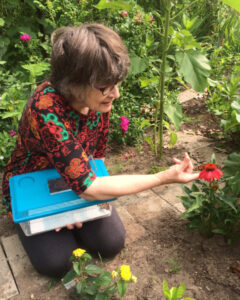
Monarch Summer 2022
2021 life cycle from egg to monarch butterfly
Incredible.
As I was reading your essay, I thought how much I would love a video and there it was!
This is inspiring and I wonder if milkweed and migration covers Florida? I plant milkweed in Minnesota but never check the leaves. You put so much care and attention into noticing the butterflies. Thank you for your guardianship!
Thank you so much for your comment. Check local butterfly resources. You may be located in a warmer part of Florida where they may stay. Or if they migrate they will be in the first bunch back, the first generation.
The best thing you can do is to plant milkweed and nectar flowers.
Sincerely,
Marcia
Monarchs are so beautiful and precious. Thank you Marcia for all your wonderful work to preserve them. I really enjoyed the details of their life.
Thanks so much, Dawn. I appreciate your comment. One of these days we will paint them.
Amazing article, Marcia! Knew a lot of what you shared, but still learned something. Love the pictures of you and your grandkids too, and applaud you for being an ambassador for Monarch butterflies. With good wishes that your work spreads far and wide like the ripples of a stone tossed in a pond so that many will be inspired to help these beautiful beings and all our pollinators!
Thanks much Sarah! The best thing is that it is a family project. I babysit their eggs, caterpillars, and Chrysalides if they are going out of town and they do the same for mine.
There is a deep love for the monarchs and for our gardens.
What a wonderful and informative essay. As I read your words I began to understand your love for the magnificent critters we all see fluttering around in our gardens and often pay to little attention to. Thanks for taking the time to share your love of the Butterfly with us all.
Thanks so much, Alan. I really appreciate your words.
Hello,
I began raising Monarchs the summer of 2019 after my dearest love, my husband of 50 years passed. For me it is a marvelous way to experience the metamorphosis – from the Latin and Greek words for transformation.
It is the profound, radical and complete change from one state of life to another in life history.
I believe from our earthly life to Eternal life. In my religious belief it is a Resurrection.
This Monarch experience has brought to me a beautiful and awesome peace.
Excellent article! I applaud your efforts to help Monarch butterflies!